First things first, I am not an expert nor am I trying to pass this knowledge off as expertise. This post will hardly be definitive or authoritative. But I have been vermicomposting for several years and just wanted to share my experiences for any who may find it useful.
Also, another thing to state up front is that my methodology is based on my experiences (my purpose for vermicomposting) and my environment (my location in Arizona). As such, you will get invariably different mileage based on your purpose and location.
Now with that out of the way ...
When I am talking about vermicomposting I am referring to red worms (eisenia fetida). Good two-page Q and A description here:
https://www.bae.ncsu.edu/topic/vermicomposting/pubs/vermicomposting_earthworm_q_and_a.pdfYou keep worms in a 'bin' and there are lots of different ways to construct them and for different purposes. I will talk about several of them that I use in this post. For a more complete list of a lot of different designs, look here:
http://www.redwormcomposting.com/category/worm-bins/. But when I talk about a bin, I am referring to a worm container that is not the ground or a garden. Something that is kept inside / in a garage / above ground outside.
I have some pretty specific constraints with my environment in Arizona (a little southeast of Phoenix). I have found that redworms tend to become ineffective around 90-95 F and they start dying above 95 F. (Although the worm cocoons can withstand a much higher temperature). I start getting average temperatures in the 95 F range in June so any worms in my worm bins die (which I discovered to my disappointment the first year I tried it). So what I do is dig a hole in the middle of my gardens or on my fruit tree mounds and in late May I dump the worm bin contents, so they can continue living in a cooler ground environment (and I get the direct benefit of having them in the soil). But what this means is that I need to get new worms for vermicomposting in October when the temperatures cool down again. I don't try to get them back out of the soil because a) it would be ineffective, they have spread out, b) I would cause a lot of damage to the soil and trees uprooting it to sift for worms. You need ~1000 worms to make a pound, and you need a few pounds of worms to do effective vermicomposting.
With that preamble, here is my basic yearly vermicomposting process:
1. In late May I dump all my worm bin contents into my gardens and fruit tree mounds before it gets too hot for the worms
2. In June-September I layer carbon rich contents (leaves mostly) and nitrogen rich contents (old/spent garden plants, tree prunings, green yard waste cut up finely) and composted steer manure. Wet it good and let it sit in the worm bins for very effective hot composting in the AZ summer (lots of thermophilic bacteria).
3. In October I order a fresh batch of worms (5 lbs. is a good amount) and start these in my small worm bins. The compost from the summer is on its way to being broken down, and is a good environment for the worms. I find they take to it right away.
4. In October-January I am feeding the worms in the small worm bins (which I keep in my garage) kitchen scraps (vegetable only), pulverized egg shells and coffee grounds (which they love). Any vegetable food prep waste is good. If the bins start getting too 'mucky' I use SoPhresh cat pine litter (
http://www.petco.com/product/126506/So-Phresh-Odor-Neutralizing-Pine-Pellet-Cat-Litter.aspx - it is made only from compressed lumber by-products) to dry it out a little. I sprinkle the pellets right on top and then wait a day for them to start to break down and absorb moisture and then work them into the rest of the bin. One of my small bins is a feed-through worm bin (more on that below).
5. In February after the worm populations have grown in the bins (healthy worm colonies double in size every 3 months or so under ideal conditions) I transfer the contents to the outdoor worm bins to work on the much larger volume of compost. Also at this point my feed-though worm bin is very active and good quality finished compost is coming out of the bottom. I use this compost (which is drier and easier to work with and is free of worms) to make my vermicompost tea.
6. In February-May the large bins continue to get worked on by the worms and I continue to make vermicompost tea. I am still adding vegetable waste to the feed through bin and outdoor bins. It is adding fresh food and diverse nutrients to the worms.
7. Late May, repeat the cycle
Basic Small Indoor / Garage Worm Bin (Rubbermaid tub design):
------------------------------------------------------------------
This is the basic bin to get everyone started with vermicomposting. Very good tutorials can be found here:
http://www.redwormcomposting.com/getting-started/ and here:
http://tropicalfruitforum.com/index.php?topic=5679 These links provide all the info you need. I will just show a picture of my bin below
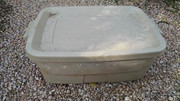
Flow Through Worm Bin:
------------------------------------------------------------------
The basic idea behind a flow through worm bin is that there is a false bottom / screen of some sort that allows air to dry out the wet vermicompost (which is very wet and 'knits' with all the protein in it). Once it is dry it falls out though the screen. You make the bin deep enough so that the vermicompost coming out of the bottom is mostly finished (not a lot of discernible stuff in it). More on the topic and designs here:
http://texasredworms.com/tag/diy-flow-through-worm-bin/My design is small (because I don't need a lot of throughput since I am just a backyard grower and gardener) and is basically 24" long x 10" wide x 12" tall. I have 1" steel mesh on the bottom. The walls are pine board and I stapled plastic sheeting to the inside so that it would hold in moisture better and the wood won't rot. I just bent the screen around the outside bottom of the bin, used a Dremel to cut off the excess in the corners and stapled it to the outside. I have the bin sitting on some blocks for airflow underneath. This is a very basic flow through bin, no bells and whistles.
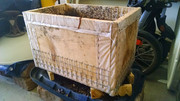
Here is a view of my flow through bin from the top. Note the cheap meat thermometer in the corner, just so I can monitor temperatures and think about moving contents when it gets too hot. This bin is absolutely *loaded* with worms.
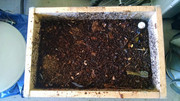
Outdoor Worm Bins:
------------------------------------------------------------------
If my outdoor worm bins look like garbage cans ... it's because that's what they are. The only thing i did was I drilled a bunch of 1/8" holes in the sides (7-8 holes in a vertical row and 8-10 rows around the circumference of the bin) for air flow (worms need to breathe - which they do through their skin). If there were no holes the bottom of the can would be a smelly anaerobic mess.
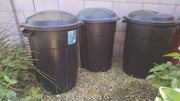
Red Worms
------------------------------------------------------------------
Once your worms get established, after a few months you want to see lots variation in your population. See this image below that has a lot of adult worms (bigger, redder, and obvious yellow tips), juveniles and baby worms. This means they are happy and establishing their life cycle.
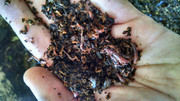
You also want to see lots of cocoons (which is where your new worms hatch from):

Vermicompost Tea
------------------------------------------------------------------
Carlos wrote a post today asking about compost tea:
http://tropicalfruitforum.com/index.php?topic=15099.0 and I wrote a response here:
http://tropicalfruitforum.com/index.php?topic=15099.msg192118#msg192118 . I will include my vermicompost tea recipe from that post here for convenience.
One of the fertilizers that I use is Urban Farms Bio-Active which has all kinds of good stuff in it including Mychorrizae. I put a handful in the bag with my castings when I brew the tea. However I don't believe the mychorrizae are multiplying during the tea making process. They form a symbiotic relationship with plant roots and do most of their growing and multiplying there (mineral and food exchange with host plant, etc.). But what I think the real benefit is, is that the mychorrizae are evenly distributed in the tea at the end of brewing and when you put it on the plants (I typically do my tea as a soil drench) they are in an environment where roots are immediately stimulated and can form quick bonds with tree roots. My very unscientific take

Carlos brought up the
good point that BioActive has Bat Guano and Poultry Litter, so does it have place in a tea? (pathogens). This is a good question,
and my response is: The chicken litter and the bat guano are both composted, so the heating and breakdown process does help to remove pathogens. And this fertilizer is *very* dry. It has some small dry particles but most of it is powder. So it does seems like it has been fully broken down. I agree, there is some concern there. I personally think the reward is higher than the risk. But I use it also because I have it on hand as part of my normal fertilization regimen. And since I am a backyard grower I don't keep a large variety of fertilizers and inoculants.
So please consider the Bio-Active an *OPTIONAL* ingredient in the tea recipe below. In fact, it is all optional except for the vermicompost.
Resources:
http://www.extension.umn.edu/distribution/horticulture/M1309.htmlhttp://www.redwormcomposting.com/worm-tea/making-vermicompost-tea/http://faq.gardenweb.com/faq/lists/organic/2002082739009975.htmlhttp://www.bioag.com/images/BioAg_Compost_Tea_Recipe.pdf2x 5-gallon buckets
20 gallon air pump
Tubing with Tee
2x Air stones
2x Large muslin bag
Long handled brewing spoon
2x 5 gallons of water (sit out overnight to dissipate chlorine)
2x 1 quart of worm casings
(rest of these are optional, but I used them)
2x 3 oz Neptunes Harvest Hydrolyzed fish
2x 2 oz Urban Farms Bioactive Dry (**SEE DISCUSSION ABOVE**)
2x 2 oz Texas Greensand
2x 1 tbsp unsulphured organic molasses
2x 1/2 tsp of Epsom Salts (for Magnesium)
2x 1 oz Apple Cider Vinegar
Collect water into 5-gallon buckets and let sit overnight. Use a food grade plastic bucket (lowes), stackable. Let the buckets sit in the sun during the day to burn off chlorine.
Place aerator in bucket 2 hours before brewing to increase oxygen and further drive out chlorine.
Put the vermicompost and dry ingredients into muslin bags and put in bucket. Dump in rest of the ingredients and give a stir.
Aerate for 24 hours and give a stir halfway through or so.
Turn off pump, remove tubing and use the mixture in the next ~45 minutes
Dilute as needed for your application
 Glad to hear it is doing well in southern CA, seems like it would probably do well here too.
Glad to hear it is doing well in southern CA, seems like it would probably do well here too. 





